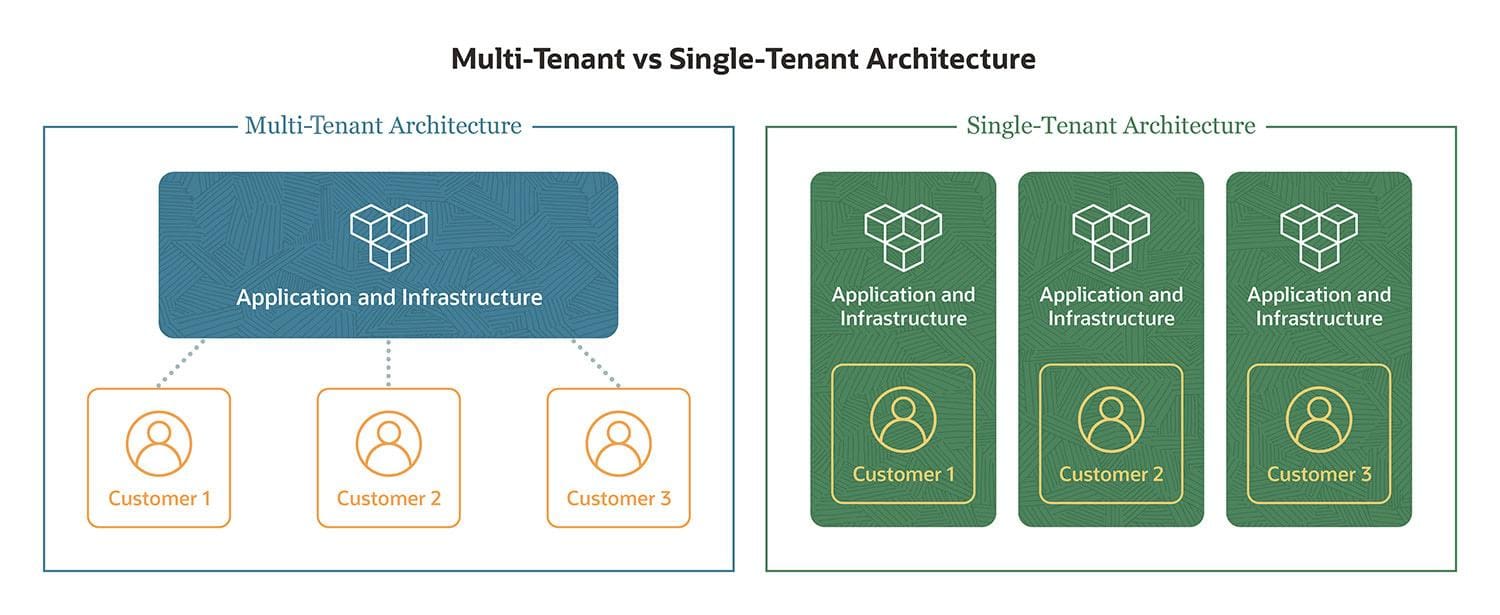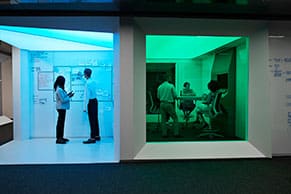Today, most businesses use at least some cloud-based software, whether for personal productivity, enterprise resource planning (ERP) or videoconferencing. Some key business benefits of those cloud-based applications — like instant access to new features, scalability and flexibility to accommodate change and lower operating costs — are attributable to the fact that these systems are built on a multi-tenant architecture.
Multi-tenancy enables cloud software providers to maximize economies of scale and focus on innovation while building an environment that can support vast numbers of customers worldwide. As a result, it’s become the most common model for developing and delivering cloud-based services to both consumers and businesses.
What Is Multi-Tenancy?
Multi-tenancy is a cloud software architecture in which a single instance of a supplier’s software is used by multiple customers. Multi-tenancy is advantageous for cloud providers and customers alike, which is why it’s become such a popular cloud software delivery model.
Multi-tenant cloud vendors need to develop and support only a single version of software, which reduces their costs while enabling them to scale the number of customers they serve and focus their efforts on adding innovative new features. This translates into affordable and high-quality software for customers, who are also relieved of the complexity and cost of managing hardware and software. In fact, multi-tenancy has made it possible for small businesses to benefit from enterprise-class applications like CRM and ERP.
Key Takeaways
- Multi-tenancy is a cloud software architecture in which a single instance of a supplier’s software is shared by many customers, known as tenants.
- Leading suppliers of cloud-based software and services overwhelmingly use multi-tenant architectures.
- Advantages of multi-tenancy include lower costs, faster delivery of new features, reduced administration and scalable performance.
- While multi-tenancy is advantageous for most companies, businesses that have unique applications or compliance requirements may benefit from a single-tenant model.
Multi-Tenancy Explained
Multi-tenant environments efficiently share computing resources among multiple customers, or tenants. Although the provider delivers the same version of software to all customers, each customer has its own separate set of data and typically can customize and configure the software to meet its needs. The services and data that each customer uses are invisible to other tenants.
Multi-tenancy is analogous to a multistory office building in which different businesses occupy each floor. Every company has its own space, while sharing services like electricity, security and cleaning. However, each company has zero visibility into what its neighbors are doing above or below. Each tenant’s operations, intellectual property and data are entirely hidden from other tenants.
How Does Multi-Tenancy Work?
With multi-tenancy, suppliers take on the complexity of building an environment that can scale to support many thousands or even millions of customers. By doing so, they make accessing applications simpler and less costly for businesses, which no longer have to worry about building IT infrastructure or installing and managing software.
In a multi-tenant cloud, tenants are physically integrated in that they share the same environment, but they are completely isolated at a logical level. This setup ensures separation among customers while giving businesses the flexibility to customize the software to match the way they operate. That’s important, because even companies in the same industry can differ widely in their needs.
Importance of Multi-Tenancy
Multi-tenancy plays a critical role in delivering software as a service (SaaS) and, more broadly, in facilitating innovation. The vast majority of leading cloud-based service providers, from music-streaming companies to cloud ERP(opens in new tab) suppliers, build their products using a multi-tenant model. Multi-tenancy enables suppliers to scale their offerings to support thousands or even millions of customers. Moreover, SaaS companies can optimize IT spend with flexible cost models and customize their multi-tenant model to accommodate different types of tenants and package and price their services accordingly. Additionally, these models are also often billed as operating costs rather than capital expenses, making costs more consistent quarter to quarter and budgeting more predictable.
Multi-tenancy also offers benefits for businesses. Overall costs and complexity are usually lower, and companies generally pay on a subscription basis and don’t need to invest in or manage their own IT infrastructures. When the supplier releases a new version of its software, it’s immediately available to all customers, so there’s no need to worry about staying current with the latest features.
Multi-Tenancy vs. Cloud Computing
People sometimes conflate multi-tenancy with cloud computing. However, although they often go together, the two terms have distinct meanings.
What is cloud computing?
Cloud computing is an approach in which companies access computing services on demand via the internet. These services can vary from infrastructure, data storage and development tools to a wide variety of business applications. Cloud computing has revolutionized the way that companies use technology. Rather than installing and managing IT infrastructure in their own data centers, companies can simply access software and other services over the internet. Generally, cloud computing customers pay for these services on a subscription basis.
Key differences.
The term “multi-tenancy” refers to an architecture in which a single instance of software serves multiple users. Multi-tenancy existed before the rise of cloud computing; companies shared access to mainframe systems way back in the 1960s. But multi-tenant architectures lend themselves particularly well to cloud service delivery. Cloud suppliers use a multi-tenant architecture to build SaaS applications and other cloud services, deliver them to businesses worldwide via the internet and scale them to meet customers’ growing needs.
Types of Multi-Tenant Architectures
Multi-tenant cloud infrastructure can be implemented in a few ways. Each option represents a different approach to sharing resources among customers. The choice of architecture depends on the application and customer needs.
-
Single application and database.
A single instance of the database, as well as the application, is shared among multiple customers. This approach, sometimes called “shared everything”, is the simplest for suppliers to manage and maintain. To maximize isolation among customers, each customer can be provided with a separate database schema and set of database tables holding their data. Alternatively, multiple tenants’ data can be stored within the same tables, with the software maintaining isolation among customers.
-
Single application, multiple databases.
Each tenant has its own database, with a separate schema and set of tables. This maximizes isolation but can require more management effort from suppliers.
Multi-Tenant vs. Single-Tenant
Multi-tenant and single-tenant architectures are two ways to deliver cloud services. In a multi-tenant environment, a single instance of the supplier’s software is shared among multiple customers.
With a single-tenant architecture, the supplier provides each customer with a dedicated instance of the software they need. For example, each tenant would have its own instance of business application software, as well as the database and other software needed to support the application. Because of this, a single-tenant architecture requires more computing resources and generally results in higher costs and more administrative effort for customers.

Benefits of Multi-Tenancy
Multi-tenancy delivers a range of benefits from cost savings to automatic software upgrades and a reduced administrative burden. Here are four crucial benefits:
-
Automatic software updates.
With multi-tenant software, customers do not have to worry about installing software upgrades and patches. Whenever the supplier updates the software, every tenant immediately gets access to the latest version. Moreover, leading suppliers ensure that upgrades are nondisruptive and that any customizations that customers have made carry over to the new version.
-
Lower cost for providers and customers.
Multi-tenant providers have to create and support only one version of their software applications for a single, cloud-based IT environment. This requires less time and fewer resources and thus delivers more predictability and cost savings that providers can then pass on to customers.
-
Faster innovation is a major advantage of multi-tenancy.
Multi-tenant providers can focus on enhancing a single, centralized version of their software rather than having to maintain multiple versions for different operating systems and customers. This speeds up application development and rollout.
-
Scalability.
Businesses don’t need to worry about adding computing capacity as they grow and add employees; they simply expand their subscriptions and scale up or down efficiently.
Disadvantages of Multi-Tenancy
Although multi-tenant solutions meet the needs of most companies, there are potential concerns to be aware of. In addition, some companies may have unique needs that can be better served by a single-tenant approach.
-
Shared security.
While leading providers of multi-tenant cloud software offer more robust security controls that most businesses can realistically build themselves, a shared environment also means uniform, shared security measures. Businesses with unique compliance requirements or those at particularly high risk of cyberattack will want to examine these measures carefully to determine whether they meet their needs or whether additional access controls to protect sensitive data are warranted.
-
Outages.
Disruptions to a shared environment can affect every tenant. Prolonged outages are rare, but extreme weather events, human error and the occasional coding mishap may still cause widespread downtime. However, it’s worth noting that many datacenters and managed service providers have DRaaS and backup environments for limited disruption. They often have A/B duel connectivity, so if connectivity is disrupted then data and connectivity can easily be rerouted.
-
Less flexibility.
Some customers opt for single tenancy because they have their own unique applications, or they need more flexibility and control over how their applications are developed and managed. Some government agencies have tight constraints on how environments are set up, especially on a multi-tenant cloud environment.
Requirements of Multi-Tenancy
Suppliers of SaaS and other cloud-based services need to focus on key customer requirements when building business applications in a multi-tenant architecture. Here are two key points to consider:
-
Customization.
Every business has different data management needs and workflows. Therefore, it’s important to enable companies to customize software to suit their needs. Businesses that want all their applications to have a consistent look and feel may want the ability to customize the user interface, for example. Others may want to integrate applications with custom software or with other data sources. Highly regulated firms might require customized access rights for compliance reasons.
-
Consistent quality of service.
When serving multiple businesses via a multi-tenant model, each customer should be assured of a high standard of performance, security and reliability. It is particularly important to ensure isolation among tenants and deliver consistent performance for mission-critical applications.
Examples of Multi-Tenancy
Multi-tenancy has become the norm in many industries, and leading providers increasingly deliver software and services via a multi-tenant cloud architecture. These services range from productivity applications like Microsoft 365 and business applications like NetSuite’s ERP suite to videoconferencing platforms like Zoom. Because multi-tenancy is the most effective way for vendors to build and deliver cloud-based applications, innovative new multi-tenant applications emerge every day.
Multi-tenancy continues to grow in popularity because of the benefits for suppliers and customers alike. Leading multi-tenant solutions provide immediate access to new features, relieving businesses of the need to install software releases and patches. They provide high levels of performance, availability and security, while enabling customization and reducing administrative effort for businesses.
Award Winning
Warehouse Management
Software
Multi-Tenancy FAQs
How is multi-tenancy different from virtualization?
Virtualization technology enables a software supplier or business to combine applications from multiple physical servers onto a single virtual server. Virtualization creates software-based virtual machines, each supporting an operating system, database and applications. Multiple virtual machines can then be installed on a single physical hardware server. Multi-tenancy differs from virtualization in that a single instance of an application and database supports multiple customers. This approach uses resources more efficiently than virtualization because it doesn’t require dedicated software and resources for each customer.
What value does multi-tenancy provide?
Multi-tenancy delivers a benefits ranging from reduced management overhead and lower operating costs for businesses to on-demand scalability and faster access to new features.
What is multi-tenancy and its advantages?
Multi-tenancy enables suppliers to support multiple customers with a single instance of software. Advantages for businesses include faster access to new features, the ability to scale to meet growing business needs, better security and lower costs.
What is meant by multi-tenancy in cloud?
Suppliers that use a cloud-based multi-tenant architecture use a single version of software to support customers worldwide. Most leading cloud-based business applications and services are based on a multi-tenant architecture.
What is single-tenant vs. multi-tenant?
With a single-tenant architecture, a vendor provides each customer (tenant) with a dedicated instance of the application and other software they need. By contrast, in a multi-tenant environment, a single instance of the software is shared among multiple customers.
What are the three multi-tenancy models?
Various multi-tenancy models exist. For example, suppliers may implement an architecture that shares a single database and schema among multiple tenants, shares the database but provides a separate schema for each tenant or provides a separate database for each tenant.
What is multi-tenancy in database?
Database multi-tenancy means that a single database serves multiple customers. Each customer’s portion of the database is isolated from and invisible to other customers using the database.
What is the characteristic feature of multi-tenancy?
The characteristic feature of multi-tenancy is that a single copy of software supports multiple customers. This provides a number of advantages, including lower cost due to more efficient use of resources and faster access to innovation.









